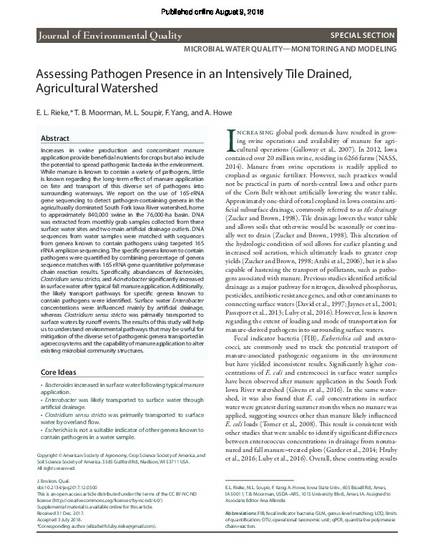
Increases in swine production and concomitant manure application provide beneficial nutrients for crops but also include the potential to spread pathogenic bacteria in the environment. While manure is known to contain a variety of pathogens, little is known regarding the long-term effect of manure application on fate and transport of this diverse set of pathogens into surrounding waterways. We report on the use of 16S-rRNA gene sequencing to detect pathogen-containing genera in the agriculturally dominated South Fork Iowa River watershed, home to approximately 840,000 swine in the 76,000-ha basin. DNA was extracted from monthly grab samples collected from three surface water sites and two main artificial drainage outlets. DNA sequences from water samples were matched with sequences from genera known to contain pathogens using targeted 16S rRNA amplicon sequencing. The specific genera known to contain pathogens were quantified by combining percentage of genera sequence matches with 16S rRNA gene quantitative polymerase chain reaction results. Specifically, abundances of Bacteroides, Clostridium sensu stricto, and Acinetobactersignificantly increased in surface water after typical fall manure application. Additionally, the likely transport pathways for specific genera known to contain pathogens were identified. Surface water Enterobacter concentrations were influenced mainly by artificial drainage, whereas Clostridium sensu stricto was primarily transported to surface waters by runoff events. The results of this study will help us to understand environmental pathways that may be useful for mitigation of the diverse set of pathogenic genera transported in agroecosystems and the capability of manure application to alter existing microbial community structures.
Available at: http://works.bepress.com/adina/33/

This article is published as Rieke, E. L., T. B. Moorman, M. L. Soupir, F. Yang, and A. Howe. "Assessing Pathogen Presence in an Intensively Tile Drained, Agricultural Watershed." Journal of Environmental Quality (2018). DOI: 10.2134/jeq2017.12.0500.